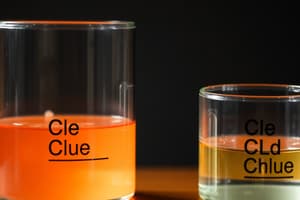Podcast
Questions and Answers
Which of the following is NOT a property of acids?
Which of the following is NOT a property of acids?
- Turn blue litmus paper red
- React with metals
- Taste sweet (correct)
- Neutralize bases
Acids react with carbonates to produce hydrogen gas.
Acids react with carbonates to produce hydrogen gas.
False (B)
What is released when acids dissolve in water?
What is released when acids dissolve in water?
H+ ions
Acids react with metals in a single displacement reaction, producing a metal salt and ______ gas.
Acids react with metals in a single displacement reaction, producing a metal salt and ______ gas.
Match the acid name with the correct chemical formula:
Match the acid name with the correct chemical formula:
What is the prefix used when naming a binary acid?
What is the prefix used when naming a binary acid?
An oxyacid ending in 'ite' will have its name ending in 'ic'.
An oxyacid ending in 'ite' will have its name ending in 'ic'.
What name is given to HCl when it is dissolved in water?
What name is given to HCl when it is dissolved in water?
Acetic acid reacts with sodium hydrogen carbonate to produce sodium acetate, water, and ______.
Acetic acid reacts with sodium hydrogen carbonate to produce sodium acetate, water, and ______.
What is a property of a base?
What is a property of a base?
What colour are these substances in acids and bases?
What colour are these substances in acids and bases?
Flashcards
What are the general properties of acids?
What are the general properties of acids?
Acids are chemical substances that are molecular compounds, react with metals and carbonates, conduct electricity, turn blue litmus paper red, neutralize bases, and taste sour.
Why do acids have their unique properties?
Why do acids have their unique properties?
When acids are dissolved in water, they release hydrogen ions (H+). These ions contribute to the characteristic properties of acids.
What happens when acid reacts with metal?
What happens when acid reacts with metal?
A chemical reaction involving an acid and a metal results in the production of hydrogen gas (H2). This is classified as a single displacement reaction.
What happens when acid reacts with a carbonate?
What happens when acid reacts with a carbonate?
Signup and view all the flashcards
How do you name binary acids?
How do you name binary acids?
Signup and view all the flashcards
How do you name oxyacids?
How do you name oxyacids?
Signup and view all the flashcards
How many hydrogen atoms are there in an oxyacid?
How many hydrogen atoms are there in an oxyacid?
Signup and view all the flashcards
What is the role of hydrogen ion (H+) in acids?
What is the role of hydrogen ion (H+) in acids?
Signup and view all the flashcards
How can you identify an acid by its chemical formula?
How can you identify an acid by its chemical formula?
Signup and view all the flashcards
How are acids used in food preservation?
How are acids used in food preservation?
Signup and view all the flashcards
Study Notes
Identifying Acids & Bases
- Acids and bases are identified using various properties and indicators.
Properties of Acids
- Acids are molecular compounds.
- They react with metals and carbonates.
- They conduct electricity.
- They turn blue litmus paper red.
- They neutralize bases.
- They taste sour.
- They act as preservatives in food.
Reaction with Metals
- Acids react with metals to produce hydrogen gas (H₂).
- This reaction is a single displacement reaction.
- Example (word equation): Hydrochloric acid + magnesium → magnesium chloride + hydrogen
- Chemical equation: 2HCl(aq) + Mg(s) → MgCl₂(aq) + H₂(g)
Reaction with Carbonates
- Acids react with carbonate compounds to produce carbon dioxide gas (CO₂).
- Example (word equation): Acetic acid + sodium hydrogen carbonate → sodium acetate + carbon dioxide + water
- Chemical equation: HC₂H₃O₂(aq) + NaHCO₃(aq) → NaC₂H₃O₂(aq) + CO₂(g) + H₂O(l)
Chemical Formulas of Acids
- When acids are dissolved in water (to form an aqueous solution), they release H⁺ ions.
- The H⁺ ion gives acids their properties.
- Acid formulas usually begin with H, followed by (aq).
- Example: HCl(g) (hydrogen chloride, gas) and HCl(aq) (hydrochloric acid, aqueous solution).
Naming Acids
- Binary Acids: Composed of H and a non-metal (groups 15-17).
- Add "hydro-" to the nonmetal name.
- Add "-ic" to the end.
- Add "acid" at the end.
- Example: HCl(aq) = hydrochloric acid
- Oxyacids: Composed of H and a polyatomic ion.
- If the polyatomic ion's name ends in "-ate", change the ending to "-ic" and add "acid".
- If the polyatomic ion's name ends in "-ite", change the ending to "-ous" and add "acid".
- Example: HNO₃ = nitric acid; HNO₂ = nitrous acid
Naming Acids cont.
- The number of hydrogen atoms in an oxyacid formula equals the polyatomic ion's charge.
- Example: Phosphate ion (PO₄³⁻) has a -3 charge. Phosphoric acid (H₃PO₄) has three hydrogen atoms.
Practice Naming Acids
- HBr = hydrobromic acid; H₂SO₄ = sulphuric acid; HF = hydrofluoric acid; HNO₂ = nitrous acid; H₂CO₃ = carbonic acid; HNO₃ = nitric acid; HCl = hydrochloric acid
Properties of Bases
- Bases are ionic compounds.
- They conduct electricity.
- They turn red litmus paper blue.
- They neutralize acids.
- They taste bitter.
- They feel slippery.
- Many bases are solids at room temperature.
Naming Bases
- Many bases contain hydroxide (OH⁻) or carbonate (CO₃²⁻) ions.
- Example bases: NaOH, Mg(OH)₂, NH₄OH, NaHCO₃.
Acid-Base Indicators
- An acid-base indicator changes color depending on whether it's in an acid or a base.
- Different indicators change color at different pH values.
- Common indicators and their colors (in acid & base):
- Bromothymol blue (yellow in acid, blue in base)
- Phenolphthalein (colorless in acid, pink in base)
- Phenol red (yellow in acid, red/pink in base)
- Litmus (red in acid, blue in base)
- Methyl orange (red in acid, orange/yellow in base)
Studying That Suits You
Use AI to generate personalized quizzes and flashcards to suit your learning preferences.




